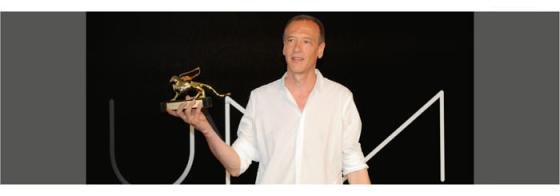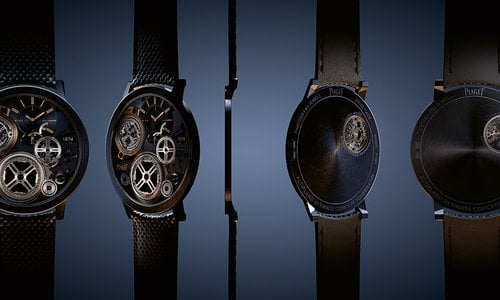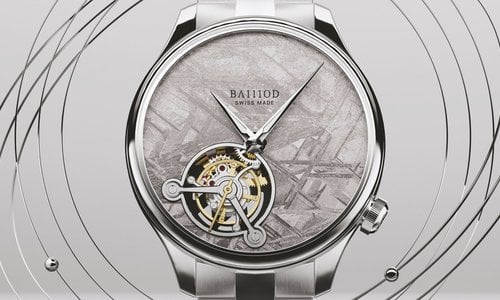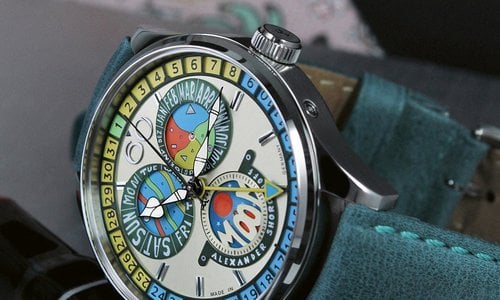The watch of the year is neither a marvel of mechanical horology, nor an ultra-slim bejewelled timepiece. It is not made of gold or steel, or some sort of avant-garde alloy. The watch of the year is not a solid object, has no real weight, and is not worn on the wrist or a fob. It does, however, show the exact time to those who look at it.
The watch of the year was not awarded the Geneva Watchmaking Grand Prix (which it perhaps deserved). Rather, it won the Golden Lion at the Venice Biennial. In fact, the watch of the year is not a watch at all, but a 24-hour long film called, The Clock.
The Clock is the work of Christian Marclay, a visual artist, film-maker, and musician. Born in California in 1955, he studied at the Ecole Supérieure d’Arts Visuels in Geneva (where he might have acquired a taste for measuring time) before returning to live between New York and London.

Clips of time in real time
The Clock is a stunning work of art. It is a fully-functioning clock that runs for exactly 24 hours and unfolds synchronous with real time. In other words, the time shown on screen is the same time as in the cinema itself. Consisting of an uninterrupted montage of thousands of film clips from every possible source that all have something to do with telling time, it features all sorts of timepieces: wristwatches, chronograph watches, gadget watches, pocket watches, clock towers (including several glimpses of Big Ben), wall clocks in train stations, offices and factories, mantle clocks, desk clocks, alarm clocks, Black Forest cuckoo clocks, a clock on a space ship instrument panel, bomb timers, atomic clocks, even hourglasses and sundials.
These timepieces are portrayed in every state: people check them anxiously and look at them lovingly; they are smashed, they explode, or they change into a weapon (James Bond appears often). They are synchronised by gangsters right before a bank robbery. They are found broken on the wrists of victims, given as a gift of love, handed down from father to son, excavated, pawned, shaken, and checked to see if they are still working.
Whirlwind of life
Time, what time it is, the passing time – these seem to be the central obsession of humans who, under the imperious reign of all these clocks, live, kiss, love, speak, fight, run, work, and are caught up in the implacable flow of time punctuated by the seconds, minutes and hours that tick by on the clock. As Marclay himself says, “The Clock is a giant memento mori.” This multi-faceted clock exudes tension. We watch in real time as everyone races toward death—and life—because the time that appears on screen is the same time for both actor and audience, making it all the more dizzying. A whirlwind of life, cries, joy, pain, fear and ecstasy combine and mingle in a steady stream of sound, music, and voice cleverly woven together under the inexorable tick-tock of time.

Here is an example
It is 12:04 by your watch and on the screen. In a black and white clip, a ticket inspector from the 1950s is facing a large industrial meter. He is looking at his watch, waiting to pull down a lever. The camera moves in for a close up of the dial (a Hamilton), which reads 12:04. We then see two dubious-looking men in what appears to be a bank, where a clock on the wall also reads 12:04. It is just past 12:04 on another clock bathed in red light. In front of it, a man is talking into a microphone, announcing a drop in the Financial Times Share Index. Then, we see a close-up of the clock, where the red second hand is just hitting 12:05 and we hear “BBC radio news”. Off-mic, the relieved journalist says, “That was close, whew!” Next, we see a close-up of the hands of Big Ben showing 12:05. A clock radio from the 1970s playing light rock shows 12:05 on the digital display. A finger swipes up the traces of cocaine left on a small mirror lying next to the clock and we see a bare-chested Richard Gere walking over to his closet to pick out a shirt while singing along with the radio. Next is a close-up of a pendulum swinging back and forth in a dark wood case. Max von Sydow is leaning toward us, busy with some obscure task, when he hears voices, turns and sees the clock face with Hebraic numbers showing that it is just past 12:05. At this exact moment, John Steed in The Avengers steps out of an English villa, nonchalantly leans against his Jaguar, pulls a watch out of his waistcoat pocket and looks at it closely. The camera zooms in on the watch (a Mido?); nearly 12:06. He turns when he hears the bark of a small dog next to a rubbish bin. He walks over to the dead body on the ground and turns it over. Suddenly something grabs his attention and he turns towards us... Next shot: a train station clock in colour showing 12:06. At the same time, Stéphane Audran walks over to a window, opens it and leans out, gazing off in the distance and looking magnificent. Zoom out. We are in the 19th century English countryside. A man asks a frail aristocratic woman if she has the time. She turns to her younger sister and asks “Your pretty little diamond watch?” She replies, “Don’t wear it anymore.“The seconds hand of an industrial clock ticks past noon: it is 12:06 and 3 seconds already. The country scene continues: “Can’t stand the ticking above my heart,” the sister says.”And you?” The man looks embarrassed. The scene flashes to a deserted, dusty Western town in broad daylight. You can see the tension in Henry Fonda’s intensely blue eyes. He moves slowly toward a wooden porch; we see a clock whose hands have fallen off. What time is it? Flash to a metro station platform. A young lady sets down her suitcase, waiting, and then a man walks up to her and says, “Hello mon chérie,” in an English accent. It is 12:07.

Tension mounts
And so it goes on for a full 24 hours. As one watchmaker said, it’s a “power reserve” of film. The editing is spectacular. It constantly toggles between thousands of films and manages to weave together a temporal flow that is both visual and musical, and that quickly takes on a hypnotic power. The obsession with time captivates us and pulls us into the torrent of life. The same actresses reappear in different clips and we see them age as time passes. At the top of the hour, something always happens—a particularly tense moment that frenetically culminates at noon and reaches a paroxysm at midnight, when everything is thrown into a panic. There are moments filled with every imaginable danger, which are inevitably followed by more peaceful instants. And always, everywhere, there is this sense of time pounding away, striking at us, constantly reminding us of its passing, never once loosening its grip.
The Clock: a watch, or a lesson in philosophy? Behind the aimless actions that mark the hours, minutes, and seconds in The Clock, there is an all-pervasive background sense of anxiety. Where are we going? What are we doing? What time is it anyway? How much time do we have? The time on the screen and our time become one and the same. We are in the film. We are captives of time.
The Clock is a magnificent film that, like a watch, always tells us the exact time. But beyond this precision timekeeping, The Clock touches upon something more basic, upon the very essence of time that takes us up, builds us and destroys us.
The true work of a clockmaker
The Clock is a work of art made with extraordinary craftsmanship. Over the course of several years, Christian Marclay and his assistants watched thousands of films, narrowing the selection down to the 3,000 that account for every minute in a 24-hour period. With all these components sorted and categorised, Marclay did the editing alone. One might say The Clock is a highly complicated movement. Its editing is as much visual as acoustic (sound is a constant theme in Marclay’s work), which adds to the richness and flow of the piece. More than a clock, this film is an epic ballad spanning every cinematographic genre.
The Clock, which received the Golden Lion award for the Best Artist at the Venice Biennial, has been purchased by several major international museums. Christian Marclay’s concept of synchronising the film with the real time in the cinema is part of the genius behind this work, and is the only real way of fully appreciating it.
The Clock will be shown at the Kunsthaus Zurich from 25 April until 6 May.
www.kunsthaus.ch
Reflections on Time, read more:
- Introduction: Suspended Time
- The Mastery of Time
- Hartmut Rosa: The acceleration of time
- The yurt and the equation
- Aphorisms on time
- Carte blanche: Eric Giroud
- Chronometry at the speed of light
- A meeting with Ottavio Di Blasi
- Carte blanche: The White Group
- Starry skies on the wrist
- Carte blanche: Alexis Guillier
Source: Europa Star February - March 2012 Magazine Issue




